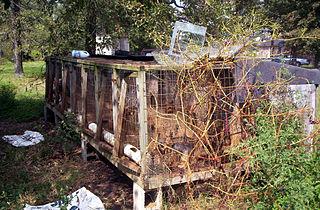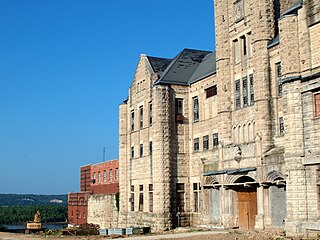
Boonville is a city and the county seat of Cooper County, Missouri, United States. The population was 7,964 at the 2020 census. The city was the site of a skirmish early in the Civil War, on July 17, 1861. Union forces defeated the Missouri State Guard in the first Battle of Boonville. It is part of the Columbia, Missouri metropolitan area.

In criminal justice, particularly in North America, correction, corrections, and correctional, are umbrella terms describing a variety of functions typically carried out by government agencies, and involving the punishment, treatment, and supervision of persons who have been convicted of crimes. These functions commonly include imprisonment, parole, and probation. A typical correctional institution is a prison. A correctional system, also known as a penal system, thus refers to a network of agencies that administer a jurisdiction's prisons, and community-based programs like parole, and probation boards. This system is part of the larger criminal justice system, which additionally includes police, prosecution and courts. Jurisdictions throughout Canada and the US have ministries or departments, respectively, of corrections, correctional services, or similarly-named agencies.

A puppy mill, also known as a puppy farm, is a commercial dog breeding facility characterized by quick breeding and poor conditions. Although no standardized legal definition for "puppy mill" exists, a definition was established in Avenson v. Zegart in 1984 as "a dog breeding operation in which the health of the mill’s dogs is disregarded to maintain a low overhead and maximize profits". They are cited as being a result of increased demand for household pets, especially after World War II. The Veterinary Medical Association of the Humane Society of the United States defines the main characteristics of a puppy mill as "emphasis on quantity over quality, indiscriminate breeding, continuous confinement, lack of human contact and environmental enrichment, poor husbandry, and minimal to no veterinary care."

The Mississippi Department of Corrections (MDOC) is a state agency of Mississippi that operates prisons. It has its headquarters in Jackson. As of 2020 Burl Cain is the commissioner.

The Missouri Department of Corrections is the state law enforcement agency that operates state prisons in the U.S. state of Missouri. It has its headquarters in Missouri's capital of Jefferson City.

Kemper Military School & College was a private military school located in Boonville, Missouri. Founded in 1844, Kemper filed for bankruptcy and closed in 2002. The school's motto was "Nunquam Non Paratus".

Minnesota Correctional Facility – Oak Park Heights (MCF-OPH) is Minnesota's only Level Five maximum security prison. The facility is located near the cities of Bayport and Stillwater. The facility is designed and employed with trained security officers to handle not only Minnesota's high-risk inmates but other states' as well. They also have the largest contract to house federal inmates with serious, violent histories. The prison has never had an escape, and only one homicide.

The Correctional Service of Canada, also known as Correctional Service Canada or Corrections Canada, is the Canadian federal government agency responsible for the incarceration and rehabilitation of convicted criminal offenders sentenced to two years or more. The agency has its headquarters in Ottawa, Ontario.

A probation or parole officer is an official appointed or sworn to investigate, report on, and supervise the conduct of convicted offenders on probation or those released from incarceration to community supervision such as parole. Most probation and parole officers are employed by the government of the jurisdiction in which they operate, although some are employed by private companies that provide contracted services to the government.
Francis Greenway Correctional Complex, formerly John Morony Correctional Complex is an Australian minimum security prison complex for males and females located in Berkshire Park, 5 kilometres (3 mi) south of Windsor in New South Wales, Australia. The complex is operated by Corrective Services NSW, an agency of the Department of Communities and Justice, of the Government of New South Wales.

John Sappington Marmaduke was an American politician and soldier. He was the 25th governor of Missouri from 1885 until his death in 1887. During the American Civil War, he was a senior officer of the Confederate States Army who commanded cavalry in the Trans-Mississippi Theater.

In criminal justice systems, a youth detention center, known as a juvenile detention center (JDC), juvenile detention, juvenile jail, juvenile hall, or more colloquially as juvie/juvy or the Juvey Joint, also sometimes referred to as observation home or remand home is a prison for people under the age of majority, to which they have been sentenced and committed for a period of time, or detained on a short-term basis while awaiting trial or placement in a long-term care program. Juveniles go through a separate court system, the juvenile court, which sentences or commits juveniles to a certain program or facility.
Fishkill Correctional Facility is a multi-security level prison in New York, United States. The prison is located in both the Town of Fishkill and the City of Beacon in Dutchess County. Fishkill was constructed in 1896. It began as the Matteawan State Hospital for the Criminally Insane.

The Utah Department of Corrections (UDC) is a government agency dedicated to the management and supervision of convicted felons in the U.S. state of Utah. It is currently led by the Executive Director Brian Nielson. It has its headquarters in the Utah Department of Corrections Administration Building in Draper.
The Correctional Industrial Facility, otherwise known as the CIF, is an Indiana Department of Corrections prison located in Fall Creek Township, Madison County, near Pendleton. It is a medium-security prison. As of 2019, the prison housed 1,471 inmates, and employed 307 staff. Constructed in 1985, CIF formerly housed the Indiana Department of Correction's PEN food products plant. However, the food products plant was replaced by a brake refurbishing factory in partnership with the industrial company Meritor, which is the largest employer of offenders in the facility. Wendy Knight is the current Warden of CIF.

The Philippine Animal Welfare Society (PAWS) is a volunteer-based, non-government organization whose goal is to prevent animal cruelty through education, animal sheltering and advocacy, based in Quezon City, Philippines. It was founded in 1954 by Muriel Jay. PAWS believes that the creation of a more peaceful society starts with the widening of mankind's circle of compassion which includes animals, thereby envisions a nation that respects animals, practices responsible pet ownership and protects wildlife. The volunteer-based organization rehabilitates these animals in the hope of finding them new homes and a second chance at a good life. PAWS does not take in pets of other people, but only victims of cruelty or neglect where the animal offenders are charged with violation of the Animal Welfare Act in court.

The Missouri State Penitentiary was a prison in Jefferson City, Missouri, that operated from 1836 to 2004. Part of the Missouri Department of Corrections, it served as the state of Missouri's primary maximum security institution. Before it closed, it was the oldest operating penal facility west of the Mississippi River. It was replaced by the Jefferson City Correctional Center, which opened on September 15, 2004.
The Sanders "Sandy" Estes Unit is a privately operated prison in Venus, Texas. It is owned by the Texas Department of Criminal Justice.

Historic District H, also known as the Missouri Training School for Boys District, is a national historic district located at Boonville, Cooper County, Missouri. It encompasses 15 contributing buildings associated with the Missouri Training School for Boys, a state juvenile detention facility. The district includes representative examples of Late Victorian style architecture. Notable buildings include the Administration Building (1890), Superintendent's Residence (1910-1917), Dining Hall (1890s), Commissary (1910-1917), and Barn.















